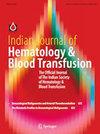Blood Supply Management Amidst COVID -19 Pandemic
IF 0.6
4区 医学
Q4 HEMATOLOGY
Indian Journal of Hematology and Blood Transfusion
Pub Date : 2022-01-04
DOI:10.21203/rs.3.rs-1023136/v1
引用次数: 0
Abstract
AIMS AND OBJECTIVES: The mandatory lockdown restrictions and curtailment strategies towards mass gatherings imposed by the government amid the COVID-19 outbreak, the organization of the voluntary blood donation camps were suspended and in house donations were limited leading to scarcity of blood With this we intend to assess the effect of this mass lockdown on our blood supply management in four phases [phase-I prior to the outbreak] ,phase-II[during the outbreak], Phase-III: The declining phase [Oct20-Feb21] and Phase IV: The second wave [March21-may21] MATERIALS AND METHOD : This is a retrospective study of twenty months of a blood bank supplying to a 1200 bedded multi-specialty Tertiary Care Academic Hospital in Lucknow. The study was divided into four phases namely: • Phase-I: Pre-pandemic phase [Oct’19 to Feb’20] • Phase-II: The full-blown pandemic phase [Mar 20-Sep 20] • Phase-III: The declining phase [Oct20-Feb21] • Phase IV: The second wave [March21-may21] Details of the blood units collected both in-house as well as in the VBDC’s were used for the study. The date of collection, expiry and date of issue for each packed red blood cell [PRBC] units were noted. The components prepared from the whole blood was also noted. The average In-house donations were tabulated. The various components issued month wise was also noted. The supply of Convalescent plasma in all the three phases was tabulate RESULT: The average whole blood collection pre pandemic was 1103 units (55%), 768units (51%) in pandemic phase, 1219units (61%) in declining phase and only 692units (21%) in second wave of the pandemic. In Phase I 27 VBDC collected 1153 units (58%) and in Phase III 8 VBDC collected 236units(12%) Due to restrictions in mass gatherings and lockdown enforced, the whole blood collections from Phase II and Phase IV was 93units (6.5%) and 76units (2.2%) only. In Phase I, the average In House Donation was 33.6%, In Phase II it was12%, In Phase III was 5.75% and lastly in Phase IV was 5.4% The PRBC issued on an average in the four phases was 59%, 48%, 55% and 26% respectively. Similarly the FFP issued in Phase I , II, III and IV was 62%,34%,58% and 20%. Lastly the RDP issued was 15%, 13%, 19% and 4.5% in all the various phases. CONCLUSION: Our study concluded that COVID 19 pandemic had a negative impact on total number of In-house donations, voluntary blood donation camps, blood stock inventory and transfusion recipients along with taking a major toll on health and safety of our blood bank staff as well. With little insight of the disease and everyday learning, by motivating more voluntary donors and health care workers the efficient chain of blood supply and demand can be maintained as the virus is to stay with us for a long time.COVID-19大流行期间的血液供应管理
目标和目标:新冠肺炎疫情期间政府对大规模集会实施的强制性封锁限制和遏制策略,自愿献血营的组织被暂停,内部献血受到限制,导致血液短缺。为此,我们打算分四个阶段(疫情爆发前的第一阶段)、第二阶段(疫情期间)、,第三阶段:衰退期【10月20日至2月21日】和第四阶段:第二波【3月21日至5月21日)材料和方法:这是一项对勒克瑙一家拥有1200张床位的多专科三级护理学术医院20个月血库供应情况的回顾性研究。该研究分为四个阶段,即:•第一阶段:大流行前阶段【19年10月至20年2月】•第二阶段:全面大流行阶段【20年3月20日至9月20日】•第三阶段:衰退阶段【21年10月20日-2月21日】•四期:第二波【21年3月21日至5月21日)研究使用了内部和VBDC中采集的血液单位的详细信息。记录了每个包装红细胞[PRBC]单位的采集日期、有效期和发放日期。还注意到从全血中制备的成分。将平均的内部捐款制成表格。还注意到按月发布的各种组成部分。结果:大流行前的平均全血采集量为1103单位(55%),大流行期为768单位(51%),下降期为1219单位(61%),第二波大流行仅为692单位(21%)。在第一阶段,27个VBDC采集了1153个单位(58%),在第三阶段,8个VBDC收集了236个单位(12%)。由于大规模集会的限制和封锁的实施,第二阶段和第四阶段的全血采集量分别为93个单位(6.5%)和76个单位(2.2%)。在第一阶段,平均内部捐赠为33.6%,在第二阶段为12%,在第三阶段为5.75%,最后在第四阶段为5.4%。四个阶段发布的PRBC平均分别为59%、48%、55%和26%。同样,在第一、第二、第三和第四阶段发布的FFP分别为62%、34%、58%和20%。最后,在所有不同阶段发布的RDP分别为15%、13%、19%和4.5%。结论:我们的研究得出结论,2019冠状病毒病大流行对内部献血总数、自愿献血营地、血液库存和输血接受者产生了负面影响,同时也对我们血库工作人员的健康和安全造成了重大损失。由于对这种疾病知之甚少,每天都在学习,通过激励更多的自愿献血者和医护人员,可以保持血液供应和需求的有效链,因为病毒将长期伴随我们。
本文章由计算机程序翻译,如有差异,请以英文原文为准。
求助全文
约1分钟内获得全文
求助全文
来源期刊
CiteScore
1.70
自引率
0.00%
发文量
82
审稿时长
>12 weeks
期刊介绍:
Indian Journal of Hematology and Blood Transfusion is a medium for propagating and exchanging ideas within the medical community. It publishes peer-reviewed articles on a variety of aspects of clinical hematology, laboratory hematology and hemato-oncology. The journal exists to encourage scientific investigation in the study of blood in health and in disease; to promote and foster the exchange and diffusion of knowledge relating to blood and blood-forming tissues; and to provide a forum for discussion of hematological subjects on a national scale.
The Journal is the official publication of The Indian Society of Hematology & Blood Transfusion.

 求助内容:
求助内容: 应助结果提醒方式:
应助结果提醒方式:


